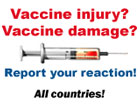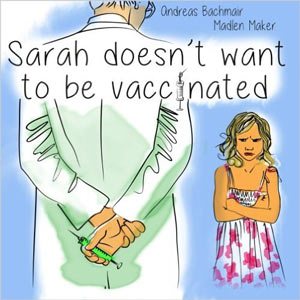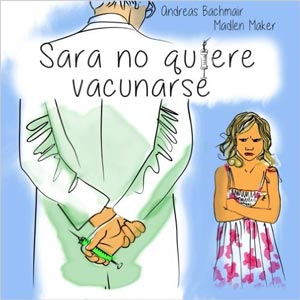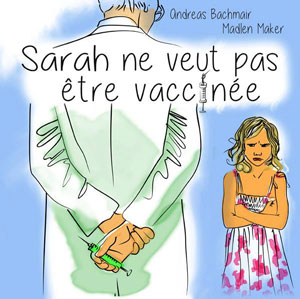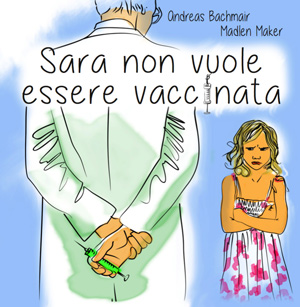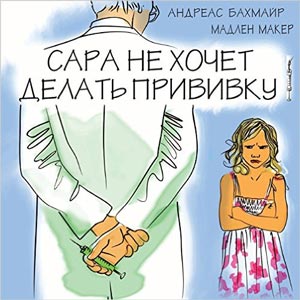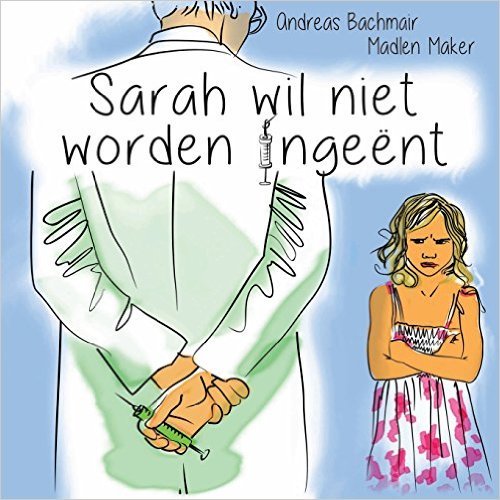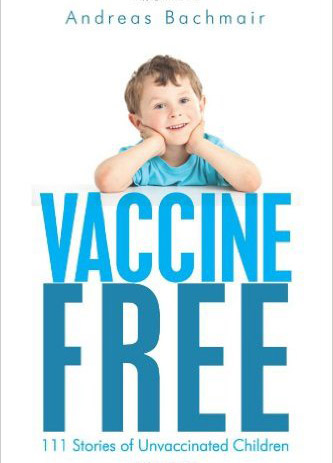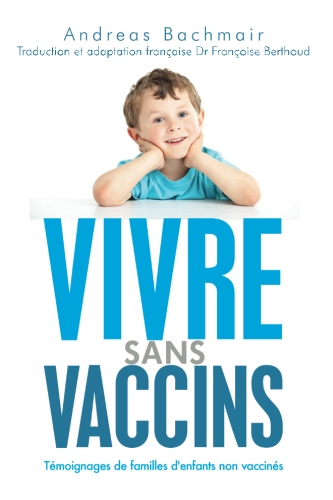HPV-Vaccination (Vaccination against cervical cancer)
Shift of HPV pathogens after mass immunisation
Benefit of the HPV vaccination?
Side effects of HPV vaccine(Gardasil, Cervarix)
As expected, in late February 2007 STIKO passed its recommendation for girls ages 12 to 17 years to be vaccinated against cervical cancer (human papilloma viruses HPV).) Contrary to its usual practice of publishing the recommendations in July it was already published in February 2007.
Vaccination
The HPV-vaccination Gardasil (Merck & Co.; sales in Europe: Sanofi Pasteur MSD) has been on the market since late 2006. The vaccination is approved for women ages 9 to 26 years and for boys 9 to 15 years.
The vaccination contains genetically engineered substances. From four HPV types: type 6, 11, 16 and 18. The two last ones are made responsible for 70% of cases of cervical cancer, types 6 and 11 for all genital warts.
Additives: Aluminium phosphate, Natriumborat, Polysorbat 80 and L-Histidin.
The basic immunization comprises three vaccinations whereas the second vaccination is administered 2 months after the first vaccination and the third vaccination 6 months after the second vaccination. (Price for all three vaccinations: 465 €).
In 2007 a second HPV vaccine was introduced for girls older than 10 years of age: GlaxoSmithKline’s Cervarix, which, however, is only for HPV types 16 and 18. This vaccine is supposed to offer a certain amount of protection against infections with HPV types 31 and 45 which are also among those types that cause cancer.
Merck Sharp & Dohme Lt and Sanofi Pasteur have supplied cross licenses to each other which allow the other company the se of patent rights to manufacture vaccines. Merck Sharp & Dohme Lt’s vaccine is Silgard and is identical to Gardasil. The German Center for Cancer Research is co-owner of the patents and will also participate in income from marketing these two vaccines (DGK).
A US-American Committee recommends the immunization against HPV mainly for 11-12 year olds, further more as a Catch-up-vaccination for 13- to 26-year olds. (Advisory Committee on Immunization Practices (ACIP): Provisional Recommendations, Juni 2006)
In Australia it was not included in the national vaccination program because there was no long-term data and its high price (Scrip 2006; Nr. 3209: 16). In Canada an expert group also came to the conclusion that there were too many unsolved questions regarding HPV vaccination and that a general recommendation regarding the vaccination against cervical cancer could not be issued yet due to potential undesired negative consequences.
However, in the USA the massive lobbying work done by the manufacturers has made it possible that in a large number of states the vaccination of all girls is seen as a prerequisite to attend school (Scrip 2007; Nr. 3237: 12)
Immunity
The trials that are required for approval had not been completely published by late 2006; they were only made public as summaries. A scientific independent review of the trials was therefore not possible
The examinations that were performed included women between the ages of 16 and 23 and 26 respectively who had had prior sexual contact with a maximum of 4 partners. It was shown that carcinomas or carcinomal prestages could be prevented by the HPV types contained in the vaccine (6,11,16,18) in women who had been vaccinated. This effect can also be proven for HPV in total (in other words independent of the subtypes contained in the vaccine) in women who had not been shown to have HPV antibodies in their serum at the onset of the trial (in other words those women who had not been infected yet).
HOWEVER: Regarding the complete group of female participants (in other words independent of the question of a pre-existing HPV-infection, corresponding with the typical female population of this age group) this effect which transcends vaccine serotypes cannot be proven.
No clinical data is available for children ages 9 to 15 years, but it is known that after the vaccination antibody levels are created which are no different than those of adult women. All in all, the vaccine could provide protection against malignant cell changes which are triggered by the HPV types that are contained in the vaccine in the initial period after the vaccination and before there is sexual activity. Women seem to profit from this kind of an early onset of the vaccination for other HPV types.
After the interim results of the FUTURE trials which have been published, the HPV vaccination GARDASIL decreases by 17% the total number of high grade cervix dysplasias (CIN 2 and higher) in women between the ages of 16 and 26, the majority of which had had sexual contacts. This is much lower than had been expected. No effect can be shown for higher grade dysplasias. An effect can only be proven in the group which did not have any sexual contact at the onset of the trial, and this only over three years (duration of the trial).
Even though the effectivity of the vaccination in women who have already had sexual contact is very low, STIKO recommends that these women have the vaccination, too „as they can also profit from a vaccination against HPV“ (Epidemiologisches Bulletin, 27. Juli 2007 /Nr. 30, S.270).
This bulletin also states that the „vaccination against HPV can be seen as an opportunity to complete other vaccinations that are recommended for adolescents. The simultaneous administration of other vaccines has only been investegated for recombinant hepatitis B vaccines. They did not influence the immune system’s response to HPV types. The clinical relevance of these findings is not clear" (Epidemiologisches Bulletin, 27. Juli 2007 /Nr. 30, S.270).
Shift of HPV pathogens
The danger is that in view of the large number of possible serotypes there may be a shift within the HPV range concerning the origin of the disease the way we experienced it for HiB or pneumococci. Thus, diseases that are triggered by HPV serotypes which are not contained in the vaccine are more frequent in people who have been vaccinated than in those who have not been vaccinated (EMEA: Europ. Beurteilungsbericht (EPAR) GARDASIL, Stand Okt. 2006: http://www.).eu.int/htms/human/epar/a-zepar.htm)
Moreover. there are indications that infections with low risk HPV such as type 6 and 11 (both contained in the vaccine) could have a protective effect against cancer from high risk HPV (16 and 18) – it remains to be seen what the effect of the elimination of low-risk HPV for the overall number of cases of cancer will be for the population as a result of the vaccinations (GARNETT, G.P., WADDELL, H.C.: J. Clin. Virol. 2000; 19: 101-11).
If HPV infections occur at a later age (which is probable after the vaccination protection recedes) their course could be much more grave, as is the case with German measles) (Lippmann, A. et al. Can Med. Ass.J. 2007; 177: 484-7).
Incidence of HPV pathogens
On Feb. 28, 07 Ärzteblatt also reported that oncogenetic hzuman pailloma viruses are not very prevalent. In 2003/2004, the National Health and Nutrition Examination Survey (NHANES)) which the US-Centers for Disease Control and Prevention (CDC) Atlanta carries out on a regular basis only resulted in a prevalence of 1.5% or 0.8% for types 16 and 18, in other words for those types that are considered to cause cancer.
In total only 3.4 of women are infected with the four types which Gardasil protects against. (http://www.aerzteblatt.de/v4/news/news.asp?id=27671)
Benefit of the HPV vaccination?
Ludwig Boltzmann Institut in Vienna performed a cost-benefit analysis of HPV vaccination for the Austrian government. Because of the similar screening conditions the results are analogous for Germany. According to the report the HPV vaccination (assumption: 65% vaccination penetration, booster, effectivity of the vaccination against persistant infections 90%) in 12-year-old girls when they are performed together with screenings by an average of 9% by 2060; it decreases mortality rate by 11%. Even under perfect conditions and assuming that the HPV vaccination was 100% effective, that 85% of all women would participate and that there was life-long protection after just one vaccination, by 2060 there would only 10% fewer incidences and 13% less mortality for cervical cancer. This prognosis clearly contradicts the expected and much acclaimed 70% reduction in cervical carcinoma, which is based on the assumption, however, that vaccinations would eliminate HPV types 16 and 18 which were shown in 70% of cervical carcinoma.( http://eprints.hta.lbg.ac.at/760/2/HTA-Projektbericht_009.pdf)
Side effects and vaccination reactions to HPV vaccination
Gardasil frequently entails local side effects at the injection site: pain (84%), swelling and reddening (25%) and itchiness (3%). 8% of the events are assessed as being grave. 10% of the people who were vaccinated develop a fever, 4% develop nausea and 3% dizziness. In connection with the vaccination urticaria, bronchospasms and inflammation of the joints were observed. Auto-immune diseases were rare but were three times as frequent in the Gardasil group than in the placebo group. (Merck (USA): US-am. Produktinformation GARDASIL, Stand Juni 2006).
It should be noted that the placebo had the same composition (other than the antigens) as Gardasil did. It contained the same problematic ingredients (aluminium hydroxide) as the vaccine itself. Thus the conclusion cannot be that the vaccination was tolerated well.
In the Cervarix trial there were serious events in 3.5% of the participants. Of the people who were vaccinated there were new chronic diseases in 1.5%, autoimmune diseases in 0.5% (Paahoven, J. et.al. Lancet 2007; 369: 2161-2170). This means that when age group is vaccinated in Germany (350.000 girls) every 200th girl contracs an auto-immune disease, in other words 1750 in total!
It remains to be noted that 0.1% of the participants (Gardasil trials) stopped participating due to side effects. These side effects are not to be found in the official publications.
Between July 2006 and October 2007 the US reporting system VAERS received reports of 3461 cases of side effects after Gardasil had been administered, of those 347 were serious in nature, including headaches, joint pain, dizziness, temporary loss of vision, facial paralysis, Guillain-Barré Syndrome and cramps. There were complictions in 18 women who had inadvertently been vaccinated during their pregnancy (miscarriage, abnormalities in the child)(http://judicialwatch.org/6299.shtml).
Eleven girls and women ages 11 to 19 years have died in the meant time in the United States immediately following an HPV vaccination.
In September 2007 an 18-year-old woman was admitted to the Klinikum Bremen-Ost who had a severe facial paralysis (Miller-Fischer-Syndrome) three days after her second HPV vaccination.
By March 2009, the Paul Ehrlich Institut was aware of 10 cases of MS after HPV vaccinations:
- Nr. 8900, Gardasil, 18 years
- Nr. 9153, Gardasil, 20 years
- Nr. 9527, Gardasil, 17 years
- Nr. 10026, Gardasil, 18 years
- Nr. 10031, Gardasil, 17 years
- Nr. 10648, Gardasil, 20 years
- Nr. 10834, Cervarix, keine Angabe zu Alter, wahrscheinlich Pharmameldung,
- Nr. 10901, Gardasil, 20 years
- Nr. 10973, Gardasil, 16 years
- Nr. 11281, Gardasil, 16 years
A new Italian study concludes that vaccines that contain parts of HPV 16 (e.g. Gardasil and Vervarix) very probably lead to auto-immune diseases! (Kanduc D:Quantifying the possible cross-reactivity risk of an HPV16 vaccine. .J Exp Ther Oncol. 2009;8(1):65-76.) This is the sentence in the original trial: The number of viral matches and their locations make the occurrence of side autoimmune cross-reactions in the human host following HPV16-based vaccination almost unavoidable.
Reports of side effects of the HPV vaccination on www.impfschaden.info were already published.
If you would like to report a side effect, vaccination reaction or vaccination damage, please click here.
Open questions:
As criticized by the Arzneitelegramm important data has not been supplied yet to assess the two HPV vaccines: It is not known what the rate is of cancer and dysplasias with HPV types which are not contained in the vaccine in the target group (women who have not been infected with HPV yet).


